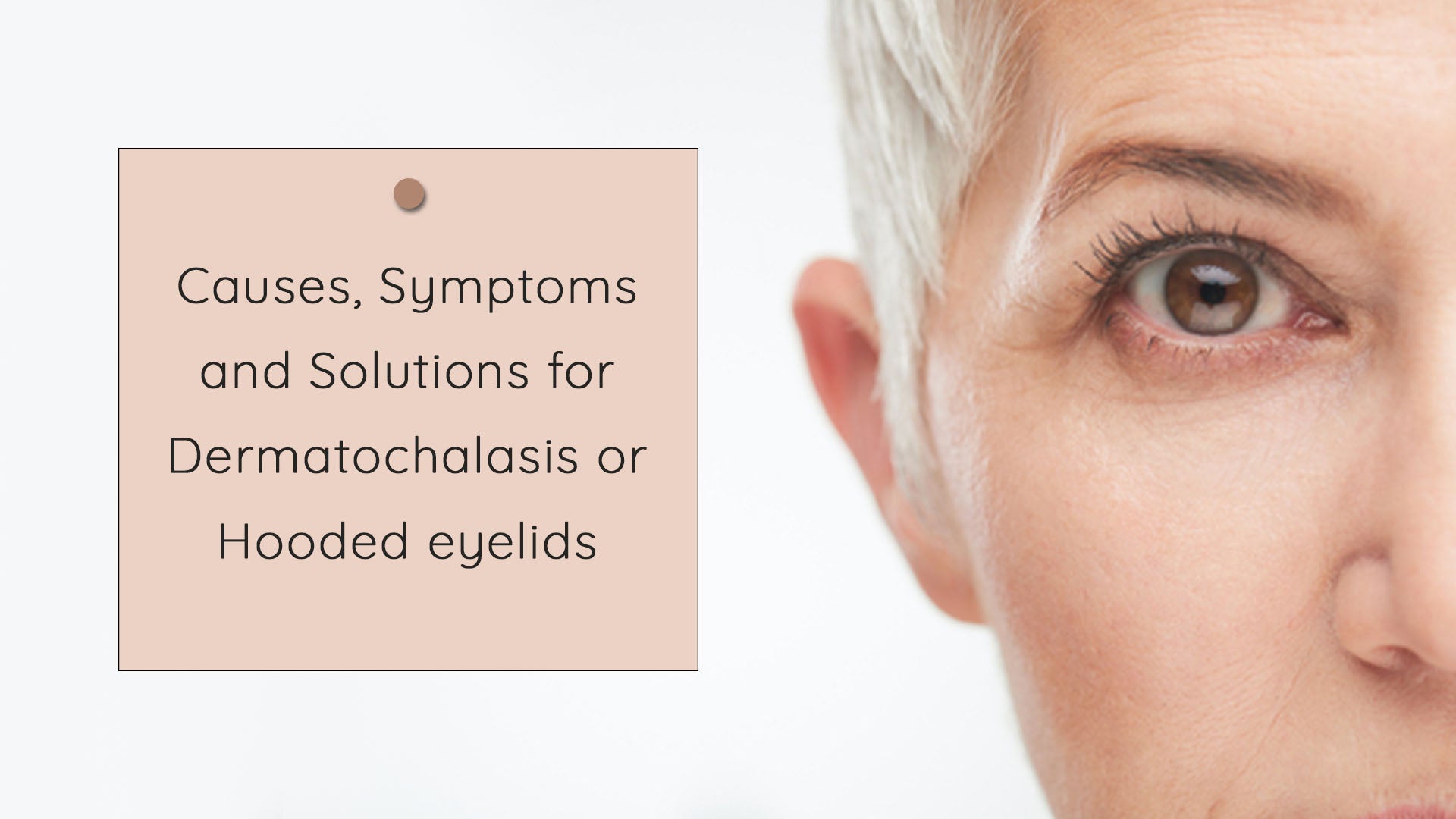Causes, Symptoms and Solutions for Dermatochalasis or Hooded eyelids

Are you dealing with tired-looking eyes? Well, we have come up with a solution that will help you eliminate tired-looking puffy and baggy eyelids. “Prevention is better than cure.” Awareness about dermatochalasis or hooded eyelids is very important to prevent it. This blog will provide you with causes, symptoms, and preventive solutions for dermatochalasis or hooded eyelids.
What is Dermatochalasis or hooded eyelids?
Dermatochalasis is a medical terminology for hooded eyelids. It is a condition that involves sagging of skin along or around the upper and lower eyelids causing puffy eyebags.
Eyelid skin is a thin and delicate part of the facial features. With aging, eyelid skin can lose elasticity causing sagging eyelids or puffy eye bags. Moreover, the constant pull of gravity may cause skin laxity which can become very prominent over time. This may not only affect your overall looks but also pose some functional issues like obstruction of vision. It may cause a major impact on appearance-related concerns like baggy upper eyelids and puffy lower eyelids.
Incidence of Dermatochalasis or hooded eyelids.
Dermatochalasis or hooded eyelids is highly prevalent among the elderly age group. It is significantly seen in the upper eyelids which are more prone to wrinkled skin. The incidence of dermatochalasis or hooded eyelids is more prevalent in males.
So, if you have taut and firm skin, it is important to take action with preventive solutions for wrinkled or saggy-looking skin.
Causes of Dermatochalasis or hooded eyelids.
The main causes of Dermatochalasis or hooded eyelids are as follows:
- High body mass index which increases facial fatty tissue.
- Hormonal changes.
- Injury in the past due to trauma or facial surgery.
- Sun damage.
- Dehydrated wrinkled skin.
- Lack of moisturization.
- Lack of sleep.
- Smoking or alcohol.
- An unhealthy diet containing preservatives.
- High salt intake.
- Lack of protein intake.
Why do Dermatochalasis or hooded eyelids occur?
The pathophysiology of Dermatochalasis or hooded eyelids is mainly due to skin aging. As aging occurs, there is a decline in elastin and protein levels from the connective tissues. The natural aging process causes a decline in elastin which is a main contributor to dermatochalasis or hooded eyelids. This condition may also occur in younger adults due to premature aging.
Wondering what elastin is? Let's explore further!
What is elastin?
Elastin is a very important level for skin texture which allows the skin to go back to its original shape after being stretched or poked. It helps give a bouncing and plumper effect to the skin thus preventing wrinkles. With the decline in elastin production due to aging, the skin does not snap back to its original shape.
Signs and symptoms of dermatochalasis
The simple way to figure out signs and symptoms of dermatochalasis is to check your mirror for upper and lower eyelids. These signs and symptoms may be present on visual inspection.
- Skin folding over itself over the lashes or pupils.
- Hanging or drooping skin on the upper and lower eyelids.
- Loose skin pulling downwards creates a gap or pouchiness.
- Puffy eyes or eyebags of the lower eyelids.
- Droopy eyelids.
- Sporadic swelling of eyes due to fluid buildup and lack of protein intake.
- Wrinkled skin around the eyes.
- Dark circles around the eyes.
- Obstructed vision due to sag over the eyeballs.
- Central or peripheral vision may be affected.
- Unable to wear contact lenses or glasses may slip.
- Eye irritation and discomfort due to redundant upper or lower eyelids.
- Entropion eyelids may turn inwards or rub against the eyeballs.
- Ectropion eyelids may cause them to turn outward.
- The heaviness of upper and lower eyelids.
- Unable to apply makeup on your eyelids.
- Difficulty in raising the eyebrows.
These signs and symptoms may affect the quality of life and overall looks which may cause low self-esteem.
Preventative solutions for dermatochalasis or hooded eyelids.
The preventive solutions for dermatochalasis or hooded eyelids are as follows-
- Follow an eyebrow and eyelash care routine.
- Invest in good eyebrow nourishing oil and eyelash oil.
- Switch over to natural skincare solutions to avoid the harmful effects of conventional skin and beauty products.
- Wear good sunscreen to prevent sun damage.
- Start with anti-aging solutions in your early 30s.
- Go for facial massages to uplift your face naturally.
- Opt for protein-enriched skincare solutions with stem cell peptides.
- Choose a good natural eye cream enriched with botanical extracts.
- Always wear the best quality sunglasses which are able to absorb the UV rays to prevent sun damage to the skin around the eyes.
- Keep yourself well-hydrated to avoid dehydration.
- Increase the uptake of protein in daily diet.
- Use clay face masks to tighten the facial skin.
- Apply vitamin c and hyaluronic acid serum to lock in moisture.
Start with these preventive solutions for dermatochalasis or hooded eyes right away in your early 30s to prevent any issues as you age.